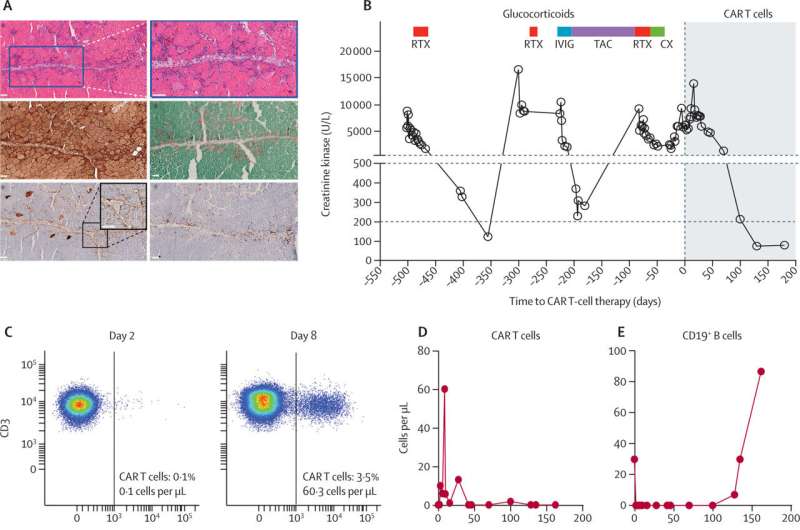This article has been reviewed according to Science X's editorial process and policies. Editors have highlighted the following attributes while ensuring the content's credibility:
fact-checked
peer-reviewed publication
trusted source
proofread
Testing their strength: CAR T-cells combat muscle inflammation

Universitätsklinikum Erlangen is the first in the world to use CAR T-cells to successfully treat a patient suffering from a severe case of muscle inflammation (myositis). The disease is triggered by a malfunction in the immune system that leads to inflammation of the muscles, and the risk of developing a very severe form of the disease is high. The Lancet has now published news of the successful treatment in a case report.
When the 41 year old Mr. S. noticed a dramatic deterioration in this health last year, he initially put it down to a viral infection. However, his health took a dramatic turn for the worse when he was suddenly no longer to move more than a few feet and was barely able to stand up. His symptoms were caused by a severe autoimmune disease affecting his muscles, joints, skin and lungs belonging to the group of anti-immune muscle inflammatory diseases (myositis). The diagnosis: anti-synthetase syndrome.
The name anti-synthetase syndrome is derived from the observation that the enzymes required for the synthesis of amino acids known as aminoacyl-tRNA synthetases are attacked in error by the immune system. This severely impacts the function of various cells.
Modifying patients' own immune cells gives hope for the future
"Autoimmune inflammatory muscle diseases are severe diseases that can end fatally if they are diagnosed at too late a stage or patients fail to react sufficiently to medicines aimed at suppressing the immune system," explains Prof. Dr. Georg Schett, Director of the Department of Medicine 3—Rheumatology and Immunology at Universitätsklinikum Erlangen.
In the case of Mr. S., all traditional treatments used to suppress the immune system failed. He was saved by CAR T-cells: "CAR T-cells are immune cells withdrawn from the patient's blood and genetically engineered to carry a chimeric antigen receptor (CAR)," explains Prof. Andreas Mackensen, Director of Department of Medicine 5—Hematology and Oncology. "Once the cells are returned to the patient's body, the CAR allows the modified immune cells to specifically target the cells triggering the disease."
Complete recovery after six months
After receiving the infusion of CAR T-cells, Mr. S. experienced a dramatic improvement in his health: the inflammation in his muscles, lungs and joints relapsed almost entirely. His strength, performance and stamina returned. "What was particularly surprising was that Mr. S. was able to stop taking all immune-suppressive medicine and in particular corticosteroids without the disease flaring up again," said Dr. Fabian Müller (Department of Medicine 5), who is caring for the patient. Six months after receiving the CAR T-cells, Mr. S. has recovered entirely from his autoimmune disease.
"It acted like pressing a reset button! Before treatment I could do nothing, and now I'm functioning like normal again," says Mr. S. This is the second type of autoimmune disease that physicians and researchers at the Deutsches Zentrum Immuntherapie (DZI) at Universitätsklinikum Erlangen have successfully treated using CAR T-cells. In the first instance, the cells excelled in treating systemic lupus erythematosus (SLE).
Other patients suffering from myositis or SLE will be offered the opportunity of benefiting from CAR T-cell treatment as part of the clinical CASTLE study, starting this year.
More information: Fabian Müller et al, CD19-targeted CAR T cells in refractory antisynthetase syndrome, The Lancet (2023). DOI: 10.1016/S0140-6736(23)00023-5




















